To the Northern Islands of Bohol
Finally, after a botched plan to visit the seaweed farms in North Bohol last Tuesday (Sept 30), canceled by the typhoon Pablo, we were able to take advantage of a lull in the weather on Thursday (October 2). The sun was up, the monsoon winds were leashed and the waters were still. Calm. Just the way I like it. To Bohol we went.
Bohol has 3 municipalities which are substantial seaweed producers in the region: Jetafe, Talibon and Bien Unido. Traditionally, the most productive is Bien Unido, specifically the island of Hingutanan which sits on the nutrients-rich Danahon reef.
I often go to North Bohol at least three times a year. We would just rent a boat at the Buot Port in Mactan, Cebu. A day trip nowadays costs about 5,500-7,000 pesos, depending on the size of the boat and the destination islands. While we always make boat arrangements before a trip, one can always do this on the day of the departure. As North Bohol is about 3 hours away from Mactan, we also start early before 8AM so that we could get back before 5PM.
Motorized outrigger interisland boats are quite noisy. Conversations are difficult to carry unless you shout over the din of the roaring motor. Soon enough though, this would just be white noise and the views of the outlying islands of Mactan and Bohol would more than provide moments of peace. Mostly, my companions would use this time to take a nap. Or, in my case, I would take photographs.
First stop in this trip was Hingutanan island. It was nip tide so the waters weren’t deep enough so we could not use the north route which goes directly to the shallow Danahon Reef. Instead, we took the more circuitous route via Talibon, where the deeper channel runs. 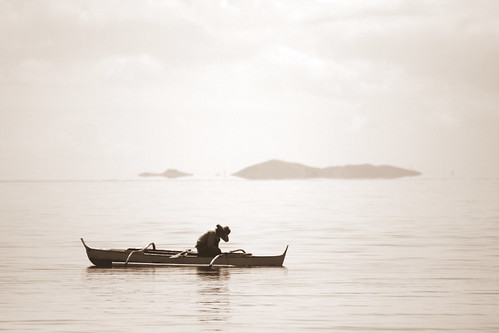
Canon EOS 350D, 1/3200s, f/5.6, 300mm, ISO100
a fisherman in the sea near Talibon, Bohol, the Philippines
When we arrived at Hingutanan, it was already way past 10AM. The seaweed platform was a hive of activity, as always. Seaweed harvests were being delivered to the farmhouse for weighing, accounting and sundrying. While it was too early for lunch, there was a bounty of seafood waiting for us so who are we to say no?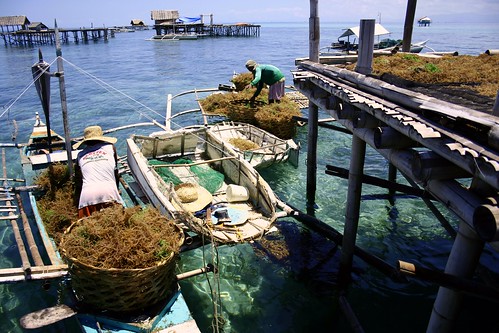
freshly harvested seaweed being delivered to a farmhouse in Hingutanan, Bien Unido, Bohol, the Philippines
After some amount of work, we then headed off to Danahon Reef to check on the health of the spinosum farms. This type of seaweed is basically growing “wild” and are hardly farmed at all. They just roll on the reef and are collected during low tide. Danahon is such a vast stretch of reef and the part north of Hingutanan is one which is relatively shallow. As the depth is probably about 3-5 fathoms deep (1 fathom, or "dupa" in Cebuano is 1 breadth of outstretched arms), the waters are not scarily dark at all but sport bright shades of aqua and green. Perfectly tempting for snorkeling!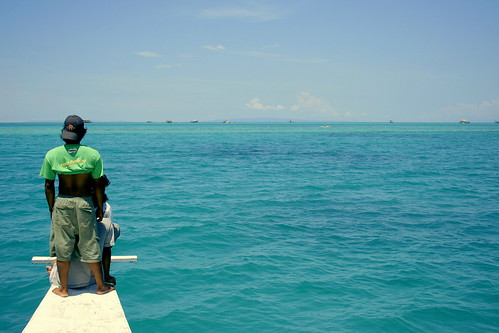
approaching the Danahon Reef (Hingutanan side), Bien Unido, Bohol, the Philippines
seaweed platforms on Danahon Reef (Hingutanan side), Bien Unido, Bohol, the Philippines
Dotting the reef are close to twenty platforms, used as farmhouses for the collecting and drying of the seaweed. The area is regulated by the municipal government of Bien Unido and hectares are being leased for a minimal amount on an annual basis. 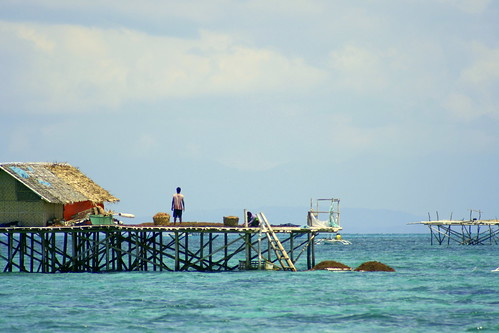
spinosum being delivered to a farmhouse in Danahon Reef (Hingutanan side), Bien Unido, Bohol, the Philippines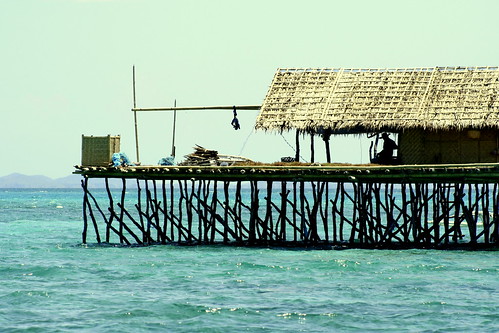
spinosum being dried in a farmhouse in Danahon Reef (Hingutanan side), Bien Unido, Bohol, the Philippines
At the reef, we had a bit of a setback as our engine conked. The detour was luckily short and we quickly found ourselves on the way to Jao island. This island, by some twist of gerrymandering, is composed of 3 barangays. (A barangay is the smallest political unit in the Philippines). One barangay, Pinamgo, belongs to Bien Unido which it faces. The western half of the island, however reports to another municipality, Talibon. Such a small island but two distinct municipality affiliations. Go figure!
The eastern coast of Jao, specifically the sitio of Lawis in barangay Pinamgo is already surrounded by monolines of farmed cottonii seaweed. It seems that growth rates are higher here than in most other islands so the coast is decked by long lines of farmed seaweed. 
cultivation lines of cottonii seaweed near the shore of sitio Lawis, barangay Pinamgo, Bien Unido-side of Jao Island, Bohol, the Philippines
For lack of space for drying, farmers in Jao prefer air-drying the seaweed, hanging them like clothes, instead of cutting the seaweed free from lines and spreading them over a platform. It is not technically the preferable mode as cleaning out plastic tie materials is difficult when the seaweed is dry.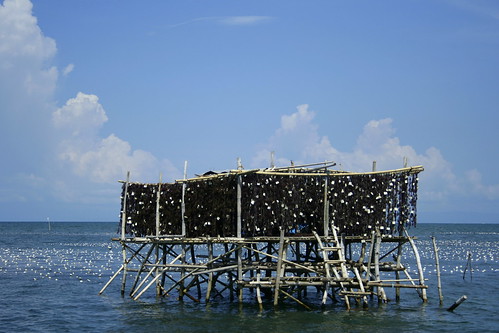
harvested lines of cottonii seaweed being air-dried in a farmhouse off sitio Lawis, barangay Pinamgo, Bien Unido-side of Jao Island, Bohol, the Philippines
harvested lines of cottonii seaweed being air-dried in sitio Lawis, barangay Pinamgo, Bien Unido-side of Jao Island, Bohol, the Philippines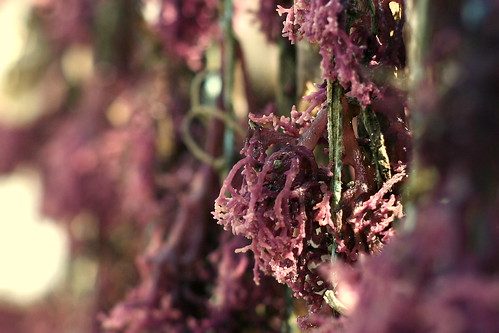
closeup of cottonii seaweed being air-dried in sitio Lawis, barangay Pinamgo, Bien Unido-side of Jao Island, Bohol, the Philippines
Of course, we had another meal in Jao island, our second “lunch” of the day. This time, we had sumptuous freshly steamed crabs and wasay-wasay shells. Work always is easier when the stomach is full, or kept full to be more exact. Too bad that we could not dilly dally as we needed to get back home.
The trip back to Cebu was uneventful. It took us 2.5 hours. Maybe our boat really was slow. Or maybe not. Distance and time have a way of warping when I visit the islands.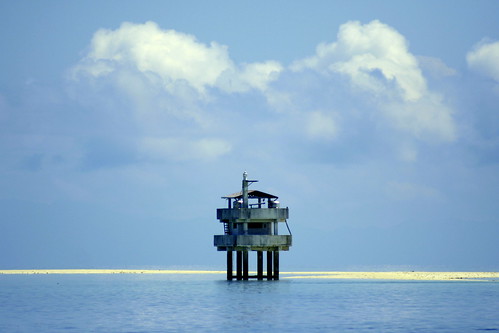
a DENR substation in the sandbar of Jao Island, Bohol, the Philippines






9 comments:
farl,
I was in this area around June, in Sagasa Island particularly. End of June is fiesta in these parts since almost all islands have San Pedro as patron. I was too tired to go around
I first went there in 1997 to accompany a high school classmate for his wedding. I thoroughly enjoyed living in a small island.
Small world ha, basta la-agan
john ada
You made fantastic pictures and I learned a lot form your descriptions. Keep going and best wishes.
Bol-anon in Germany
john- as always, you have the most enjoyable tales to tell.
bol-anon- salamat!
Farley,
I never had the chance to stumble your pics until a friend from Taiwan send me the website.
Anyways, nice pics.
I am a marine biologist specializing on seaweed culture and yours are good shots.
Ronald
Ronald- the world is small and the seaweed world is much much smaller. :-)
hello farl,
i just saw your pics and i really enjoyed it, not just fantastic pics but your promoting our place too. This Mayor Niño Rey Boniel of Bien Unido Bohol, im into photography also right now. Hope to see you soon on your next visit to our place. My office no. 038-5172288,5172391
hello farl,
i just saw your pics and i really enjoyed it, not just fantastic pics but your promoting our place too. This Mayor Niño Rey Boniel of Bien Unido Bohol, im into photography also right now. Hope to see you soon on your next visit to our place. My office no. 038-5172288,5172391
nice shots!!!
i've learned lots of knowledge since i need this for our feasibility study....
thank you so much
I stumbled upon your site while looking for the name of some seaweeds I saw in Baguio, and I just wanted to say, you are a wonderful photographer!
Post a Comment